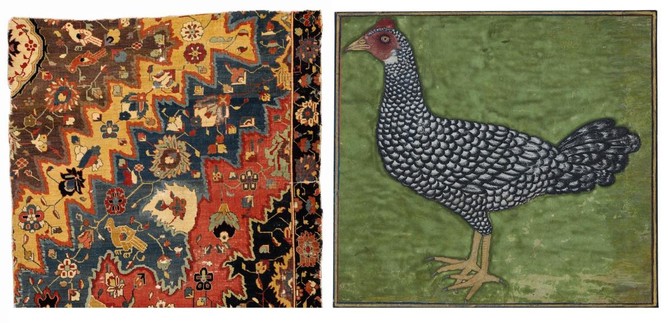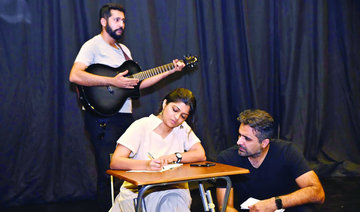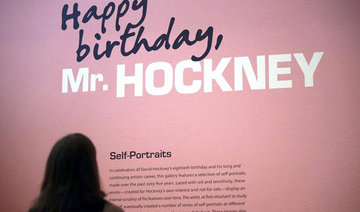LONDON: This October, Sotheby’s will exhibit some 400 items from a collection including Indian and Islamic art that belonged to renowned British artist Howard Hodgkin, to be sold at auction in London on October 24.
Hodgkin, who died in March at the age of 84, is widely regarded as one of Britain’s greatest artists. He has been a central figure in contemporary art for more than 50 years.
Frances Christie, senior director and head of the department of Modern and Post-War British Art, described the artist as highly influential.
“Howard Hodgkin redefined the way in which we look at the world. Just as his eye for the exceptional resonates through his paintings, his ability to identify the extraordinary in unexpected places was deployed in his incessant hunt for art and objects of exquisite beauty. So confident was he in his selection, and of the importance of each piece to his needs, that he created his own collecting alchemy. Spanning art history through time and geography, they offer a vivid revelation of his private world in all its intense and exhilarating glory,” she said.
Hodgkin spoke about his passion for collecting in a talk given in 1991 at the Arthur M. Sackler Gallery in Washington’s Smithsonian Institution, where Indian paintings and drawings from his collection were being shown.
From the transcript of that talk, we get an insight into his thinking.
“Everything that I’ve ever done as a collector has been based, ultimately, on the strength of feeling,” he said.
The urge to collect, he observed, can stem from many motivations.
“A great collection often seems to be the result of one very rich man going shopping. It isn’t. It is really partly illness, an incurable obsession. It’s partly — sadly, in some cases — a desire for future or posthumous glory, perhaps more often for status while the collector is still alive. Also, and of course far more importantly, it represents the human desire to get near works of art. At its worst, it’s greed or the desire simply to possess, like a child at a party being given something to take home. But it’s much more than that at its highest.”
Hodgkin remarked that he found painting solitary but that collecting brought him into contact with like-minded people. Furthermore, the discriminating eye that he developed was nurtured by close friendships with experts in the field. It was Hodgkin’s art master at Eton, Wilfrid Blunt — brother of the leading British art historian and Soviet spy, Anthony Blunt — who first introduced him to non-Western art and who inspired him to collect his first examples of Indian paintings.
Later, Hodgkin became friends with the collector Robert Erskine and through him the network of various Parisian dealers, including Charles “Uncle Charlie” Ratton. Robert Skelton, who was the assistant keeper at London’s Victoria and Albert museum, became a lifelong friend with whom the artist first visited India in 1964. It was with Skelton that Hodgkin was able to meet other connoisseurs and collectors, including Jagdish Mittal, Kumar Sangram Singh, Milo C. Beach and Stuart Cary Welch, whose own collection of Islamic and Indian art was sold at Sotheby’s in 2011.
Hodgkin wrote about his fascination with Indian art in an Asian Art article entitled “About my Collection” in 1991.
“Disconcertingly, a collection begins to have a life of its own and to make demands on its owner that seem both impersonal and peremptory. For the most part, it’s really quite easy to resist the innocent charms of gap filling. But when a picture somehow demands to be bought (at whatever price) because it appears to be a great work of art of a kind not otherwise represented in the collection, it means trouble. I long wanted marvellous Basohli pictures and eventually got some good ones. Early Mughal pictures were seemingly impossible to come by, and then, by chance, I managed to acquire the fragmentary painting on cloth (titled) ‘A Prince Riding on an Elephant in Procession,’ but my favorite and longest-lasting enthusiasm has been for Kota painting.
“Elephants are heavy animals but are depicted in paintings from Kota as capable of such wild movement that they appear almost weightless — and how mysteriously they seem to haunt the rather conventional landscape.
“As a collector, my enthusiasm for these Kota pictures became my downfall — my Waterloo. The acquisition of ‘Maharao Durjan Sal and Shri Brijnathji Hunting Tigers and Wild Buffalo’ was such a traumatic event in my life as a collector that I felt I could go no further. It’s the largest, most expensive picture I have ever bought and the only one for which I have exchanged one of my paintings. This great, though fragmentary, picture finally enabled me to escape from the almost nagging lust that often keeps collectors in a slightly restless and unfulfilled condition for the rest of their lives.”
The Sotheby’s experts who catalogued Hodgkin’s collection described a treasure trove within every room of his Georgian house in Bloomsbury, near the British Museum in London.
“Surprises lay around every corner of the house. A precious 17th century Indian sandstone relief formed a backdrop in the kitchen to the artfully-stacked china on display. A wonderful fragment from a carpet, with its interlocking geometric pattern, faced a series of wall-mounted Kashan star tiles and the foliate motifs were echoed in monochrome form in the craftsmanship of an exquisite inlaid Mughal box.”
They observed that ornamentation is a prominent thread that runs through the great variety of objects he was drawn to, from both India and Islamic cultures. He especially sought fragments — particular motifs, calligraphy, colors and textures appearing in Ottoman, Indian and Islamic tiles, textiles and rugs. Fragments of calligraphy were not sought after for their meaning, but purely for the visual language of their linear forms and he honed in on specific parts of larger pattern schemes. In doing so, he focused on small yet powerful details, freeing his imagination from the original form.
Hodgkin collected in such depth that, despite covering almost every surface of his home, many of his acquisitions were not displayed. The basement library held a rich treasure trove of prints, paintings, fabric, books and furniture and exquisite fragments. Items consigned there were not relics, but an astounding array of source material of the most varied and wonderful kind. Many items were acquired on his travels, but were never as mementos. “I particularly don’t like objects of sentiment — people who have things not because they like and admire them, but because they have associations,” the artist is known to have said.
Hodgkin, who was awarded the much-coveted Turner Prize in 1985, has been the subject of numerous international exhibitions and art fans in the Middle East will soon have the chance to view highlights from his collection at the Sotheby’s gallery in Dubai between October 8-12. The full exhibition will be on show in London from October 20-24.
Indian, Islamic art collected by UK artist Howard Hodgkin to go under the hammer
Indian, Islamic art collected by UK artist Howard Hodgkin to go under the hammer

How science is reshaping early years education

DUBAI: As early years education comes under renewed scrutiny worldwide, one UAE-based provider is making the case that nurseries must align more closely with science.
Blossom Nursery & Preschool, which operates 32 locations across the UAE, is championing a science-backed model designed to close what it sees as a long-standing gap between research and classroom practice.
“For decades, early years education has been undervalued globally — even though science shows the first five years are the most critical for brain development,” said Lama Bechara-Jakins, CEO for the Middle East at Babilou Family and a founding figure behind Blossom’s regional growth, in an interview with Arab News.

She explained that the Sustainable Education Approach was created to address “a fundamental gap between what we know from science and what actually happens in nurseries.”
Developed by Babilou Family, the approach draws on independent analysis of research in neuroscience, epigenetics, and cognitive and social sciences, alongside established educational philosophies and feedback from educators and families across 10 countries. The result is a framework built around six pillars; emotional and physical security, natural curiosity, nature-based learning, inclusion, child rhythms, and partnering with parents.
Two research insights, Bechara-Jakins says, were particularly transformative. “Neuroscience shows that young children cannot learn until they feel safe,” she said, adding that stress and inconsistent caregiving can “literally alter the architecture of the developing brain.”
Equally significant was evidence around child rhythms, which confirmed that “pushing children academically too early is not just unhelpful — it can be counterproductive.”
Feedback from families and educators reinforced these findings. Across regions, common concerns emerged around pressure on young children, limited outdoor time and weak emotional connections in classrooms. What surprised her most was that “parents all sensed that something was missing, even if they couldn’t articulate the science behind it.”
At classroom level, the strongest body of evidence centres on secure relationships. Research shows that “secure attachments drive healthy brain development” and that children learn through trusted adults. At Blossom, this translates into practices such as assigning each child “one primary educator,” prioritising calm environments, and viewing behaviour through “a neuroscience lens — as stress signals, not misbehaviour.”
Bechara-Jakins believes curiosity and nature remain overlooked in many early years settings, despite strong evidence that both accelerate learning and reduce stress. In urban centres such as Dubai, she argues, nature-based learning is “not a luxury. It is a developmental need.”
For Blossom, this means daily outdoor time, natural materials, gardening, and sensory play — intentional choices aimed at giving children what science says they need to thrive.












